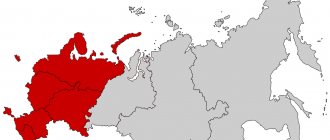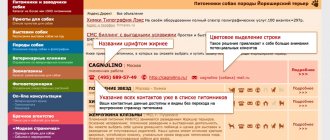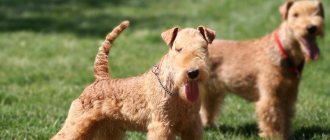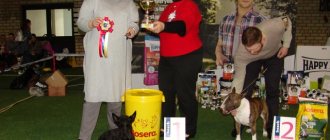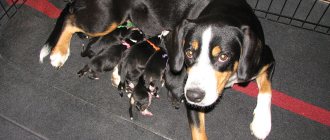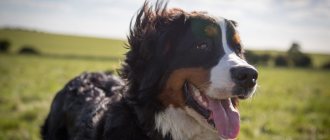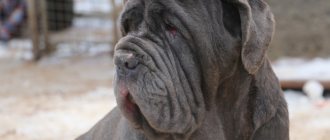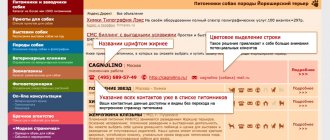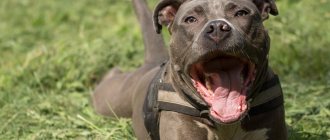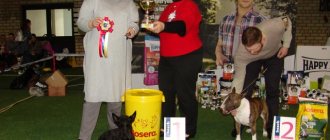- Japanese Chin
The Japanese Chin is native to Asia, where it has been bred as a companion animal for over a thousand years. He was a popular member of the Chinese and Japanese imperial courts, and it was in Japan that he acquired his appearance as we see it today. This breed is elegant and graceful, gentle and playful.
- Country of Origin : Japan
- Height at withers : 18-25 cm
- Weight : 2-4 kg
- Lifespan : 12-14 years
- Use : companion dog, hunting, guard, service dog
- Other names : Japanese Spaniel, Chin
Purchasing a Japanese Chin puppy is a responsible and important act that you need to think carefully about before doing. This is especially true for those people who are going to become truly responsible dog breeders. The question of choice should be approached carefully and without haste, comparing your own habits, daily routine and the nature of the chosen breed. When the future owner has decided on the breed, a new dilemma arises: how to find a bona fide breeder? Here you need to be extremely careful not to become a prematurely disappointed dog owner.
Buying a Japanese Chin puppy is a very exciting event, because you can say that a new family member will appear. To ensure that the event does not overshadow anything, it is worth taking a responsible approach to choosing a breeder. There are no bad dog breeds; you can simply run into an unscrupulous breeder for whom money comes first. The future owner is at great risk of buying an animal that has a lot of health problems. It is for this reason that you need, first of all, to get to know the breeder well, read reviews about him and the like.
Description of the Japanese Chin breed
Popularity 104th place among 263 dog breeds
Lifespan:
10-12 years
Breed group:
Decorative
Height:
20-27 cm
Country of origin:
Japan, China
Average price:
5-15 thousand rubles
Weight:
2-5 kg
Latest articles Cat health
Rabies vaccination for cats: choice of vaccine, necessity, schedule 01/22/2022 4 0 0
Selection and adaptation
TOP 20 best cat breeds for families with children 01/22/2022 25 0 0
Key facts
The Japanese Chin is a miniature, elegant and very sweet dog. Her ancestry is related to the Tibetan Spaniel breed, and has some family ties to the Pekingese and Cavalier King Charles Spaniel. Chins were deeply revered by the emperors of Japan and China for their grace, comeliness, intelligence and deep devotion. Other names are Japanese spaniel, or simply chin.
The main characteristic of the Japanese Chin breed is grace in behavior and elegance of movements. They are very delicate. They get used to the lifestyle of their household well and quickly. They do not tolerate and are offended by rude treatment of them; they appreciate sincere care, affection and attention.
The main description of the Japanese Chin breed in appearance is soft, flowing hair, a wide muzzle, a small bridge of the nose and snow-white teeth. Proud posture and an aristocratic look are the calling cards of Japanese spaniels, which are always in a neat appearance.
The dogs are very smart, active and friendly; a little intrusive, but only because of their boundless love and devotion to their owner. Chins rarely bark, and with their delicate behavior they are able to create a favorable atmosphere in the house. If you are going on a trip, feel free to take your little tailed friend with you - chins love to travel and behave well in any vehicle.
The health of these dogs is quite good, but it all depends on care. On average, the life expectancy of the Japanese Chin is 10-12 years, and until old age the dogs do not lose energy.
Character and behavioral characteristics
One can say with confidence about the character of Japanese Chins that this is the case when size does not matter. In the chest of these dogs, only a couple of tens of centimeters tall, the heart of a lion beats. They are brave, sometimes reckless (especially when it comes to protecting the owner), are not afraid of larger dogs, and do not herd in unfamiliar surroundings.
At the same time, other personality traits “coexist” harmoniously in Chins - tenderness, friendliness and a philosophical outlook on life. They are dispassionate like the Japanese, and just as smart, they know how to analyze and draw the right conclusions. At the same time, the Japanese Chin is a small miracle with the soul of a child and its inherent mischief, as well as a love for outdoor games.
A very important feature is self-confidence and absolute self-sufficiency: the voice of the blood tells the hin that his place is on the “throne”, and all eyes are directed only at his person. This feature must be taken into account and the dog must be given enough time to communicate.
“Problem areas” in behavior are considered to be:
- Some stubbornness - having chosen a course of behavior, this dog often achieves its goal by any means necessary.
- Poor appetite (can be leveled through sufficient physical activity).
- Touchiness, the degree of which directly depends on the ability to get along with the dog using diplomacy methods.
The most important feature of the Japanese Chin, the “pearl” of its merits, is the ability to create a special aura of peace and harmony in the home. This quality has not changed over the centuries and remains in the genes of these dogs to this day.
History of the origin of the Japanese Chin
The Japanese Chin is a very ancient breed. Most scientists consider it truly Japanese. The second version says that the animals were brought to the Land of the Rising Sun from other Asian countries.
There is a legend that two dogs similar to the Japanese Chin were presented to the Emperor of Japan Semu by the head of a certain state of Korea in the 8th century AD. And yet, the date of the appearance of dogs that is closest to the truth is considered to be the 3rd century.
Japanese spaniels are classified as decorative species, like the Shih Tzu, Pekingese, Tibetan spaniel, and pug. Such miniature animals have been bred for several centuries, initially living in the courts of emperors. Pets were presented as gifts to each other by Tibetan, Chinese, and Japanese representatives of the religious or secular elite.
The first written mention of quinine appeared around the 12th century. They were revered as sacred animals and were depicted on various objects: porcelain vases, paintings, and palace walls. The breed began to be purposefully bred in the 14th century, and all information was entered into special books and kept secret. Noble people carried tiny pets in the sleeves of their kimonos and placed them as decorations in sofa cushions or wrought-iron hanging cages. Ordinary people were strictly forbidden to keep Japanese spaniels, and their theft was punishable by death.
There is still debate about the origin of the name of the breed. "Hin" is similar to the Chinese word for "dog", and in Japanese a similar word is translated as "jewel".
According to some reports, the appearance of the breed in the West is associated with the name of the American Navy Commodore Matthew Kelbright Perry, who in the 1850s, during an expedition to Japan, received several sacred gifts from the emperor. He brought them to England as a gift to the queen. It is not difficult to guess that among the gifts there were also Japanese chins. The further development of trade relations contributed to the rapid spread of these dogs across the continents.
For the first time, purebred dogs were presented at exhibitions in the 70s of the 19th century in Birmingham, giving the name Japanese Spaniel. The World Canine Organization officially registered it under this name in 1957 and classified it as a companion dog.
Chins appeared in the Soviet Union in the 1980s, when six pets were brought to Moscow as gifts to Russian diplomats for successfully completing their service in the Japanese state. Today, many nurseries in Russia breed these beautiful creatures, whose ancestors were those six dogs.
Appearance of the Japanese Chin
Chins have a very interesting, pretty and graceful appearance. That is why they belong to decorative pets.
General impression
The Japanese Chin has a tiny size, "square format" body. Females have a slightly elongated body. In the photo of the Japanese Chin, the luxurious coat and belonging to the oriental dogs are striking.
Head
The dimensions of the head are proportional to the body. The skull is wide, rounded with a sharp transition from the forehead to the muzzle. The edge of the nose and large dark eyes are located on the same line. The head can be either dark or light in color, but more often the color of the dog’s coat. Wide nostrils facing forward.
Neck
The neck is quite short, but very strong and always raised, which allows the animal to look graceful and maintain its posture.
Torso
The body is not long, with a curved (sometimes slightly humped) back. The loin is quite wide, slightly rounded. The stomach is taut.
Forelegs
The paws in the forearms are straight, they have a rather thin skeleton, below the elbow on the back of the paws there is hair falling down. The elbows are directed clearly back and tightly pressed to the body. Pasterns sloping.
Hind limbs
Back paws with moderately pronounced corners. They are covered with long, delicate hair that resembles bell-bottoms. In general, the limbs are elongated, straight, with toes close to each other, often with tassels between them.
Tail
The tail is set high, reminiscent of a bagel thrown back. It is covered with an elegant mop of thick fur.
Movements
The movements of the Chin are very graceful, measured and proud. However, the dog is very active and nimble.
Wool
Japanese Spaniels have a very soft, flowing and delicate coat. There is practically no undercoat. The short neck, upturned ears, rounded hips and tiny tail have much more fur than other parts of the body.
Color
Most often, the colors of the Japanese Chin have chaotic spots of black, gray, brown or red. But the red color can also have a lighter or darker shade, for example, lemon, fawn or coffee. It is better not to cross Japanese Chins with dark red, even brown spots, with each other, as there is a possibility of the birth of an unhealthy or dead puppy. Ideally, the spots evenly outline the eyes, cover the ears, and are located evenly throughout the body, at the same distance from one another. A clear outline of the spots is desirable, as well as the presence of a smooth white line (notch) from the forehead to the bridge of the nose. Sometimes there may be a barely noticeable black dot on it, which is called the “Buddha finger”.
Size
The Japanese Chin is quite small in size. The length of the body reaches a maximum of 30 cm. The maximum height of the Japanese reaches 27 cm at the withers. The legs are long, the head is proportional to the body. The weight of the Japanese Chin is small, which allows you to constantly carry it in your arms. Chins love this very much. The largest individuals weigh 5 kilograms, but this is also rare.
Description of wool
with elastic pads, black claws. The tail is thrown back over the back and covered with long, silky hair. Soft, silky, almost straight and long hair covers the entire body with the exception of the head, where the hair is shorter. The throat, hips and tail are decorated with long, very rich coats. The color is white with black or red spots. White color without spots is a fault. Movements are light and free.
Personality of the Japanese Chin
Japanese Chins are loved for their agility, playfulness and intelligence. Despite their small size, they are very brave: if necessary, to protect the owner or child, they immediately rush to bark at the enemy. But if they feel obvious powerlessness, they begin to scream and hiss like cats.
These animals are very loyal, even a little obsessive. However, if you let your pet know that he is a little in the way, the furry friend will immediately understand this and will wait for the right moment of communication. He is very smart and understands commands well.
Chins are clean and not mischievous. At every opportunity, they try to lick clean the fur and paws of themselves and other animals in the house, if there are any. You don’t have to worry about furniture, shoes or clothes: Japanese spaniels don’t really like to chew things. In general, the character of the Japanese Chin is very easy and does not create problems.
Dogs are careful around children. It is not recommended to keep them in a family with small children, as the child may accidentally harm the furry. Chins are slightly suspicious of other people. In the family circle, they create a calm and pleasant aura, envelop their owners with attention and actively engage children in play.
The little family member loves walks and long trips. When traveling, he behaves obediently, tries to stay close to the person and sits calmly in his arms for a long time.
Character
Chins have a balanced character and will never bother you or your neighbors with useless barking. They may respond to a doorbell or a visit from an unknown person, but they quickly fall silent and never burst into hysterical barking to the point of oblivion; their noble origin and Japanese roots do not allow them to “lose face.”
Proud, affectionate and intelligent aristocrats of the East - Japanese chins protected the families of Japanese emperors from troubles, depression and illness, creating an atmosphere of happiness and love, pleasing the eye with beauty. They reigned in temples, driving away evil spirits with their presence. Now for you, the treasure of Japan can become a talisman and an inexhaustible source of joy and peace of mind.
Education and training
Like any dog, Chins need proper training and command training. They are flexible, so teaching them standard directions or even funny tricks won't be too difficult. It is better to try to avoid harsh and rough actions, frequent touching of the tail, face and ears of your furry friend. This type of behavior can lead to aggression.
It is better to turn raising and training the Japanese Chin into a game. It will be enough to repeat the command 5-6 times. The main thing is timely praise with affectionate words, less often with treats.
When training, be gentle with your chin just as he is gentle with you and your family. Mutual respect will create a strong bond between owner and dog that will rub off on family members and close friends.
Looking for a Japanese Chin? Find your pet from 1 offer As a gift
How to care for an emperor dog
Despite their “royal” title, quinines are quite unpretentious in their maintenance. Their silky fur has a wonderful property - it repels dirt and debris, so it’s enough to sometimes go over it with a comb, and the pet will be in good shape. In addition, chins themselves are clean by nature: they try to avoid puddles and other unpleasant places, and often, like cats, groom themselves with their tongues and paws. These dogs are not bathed often.
Since chins have hair growing between their toes on their paws, it is better to wash them after walks - then the apartment will always be clean. You also need to take care of your ears. The hanging membrane of the ear does not allow natural ventilation: bacteria can accumulate in the cavity. The area around the eyes is also a subject of inspection - it needs to be cleaned regularly with special products. “Sofa” Chins always have their nails trimmed.
Health and Diseases of the Japanese Chin
Possible diseases
Japanese Chins rarely get sick. Their ailments are common in many small breeds. They have some genetic features:
- dwarf size;
- fragile musculoskeletal system;
- large bulging eyes;
- close proximity of the nose to the eyes.
This can provoke the occurrence of a number of diseases and pathologies:
- Musculoskeletal system: displacement of the vertebrae of the neck, dislocation of the kneecaps.
- Respiratory system: difficulty breathing, glanders and wheezing.
- Endocrine systems: multiple teeth, curvature of the jaw.
- Ocular system: conjunctivitis - clogged tear ducts, inflammation, entropion of the eyelid.
But such hereditary health problems are rare. In general, dogs have a strong immune system.
Reproductive health
The bitch begins to come into heat at 8-9 months, but it is too early to think about mating: it is best to wait until the 3rd heat. Estrus in Chins is quite troublesome: the dog begins to behave differently, unscheduled shedding occurs, and in the cold season the risk of colds with inflammation of the genital organs increases.
It is better to breed Japanese Chins when they reach one year of age - this applies to both females and males. Before this period, their body is not yet strong enough. In the last 2-3 weeks of pregnancy and 3 weeks after birth, the dog needs the help and support of the owner. Therefore, during this happy period, one of the family members is recommended to take a vacation in order to spend more time with the dog.
Features of feeding and diet
According to many, feeding Japanese chins is not expensive, since the animal is unpretentious in food. But in practice everything is a little more complicated.
The food should be sufficiently high in calories, because dogs move a lot. The diet is best made up of foods containing a lot of protein, microelements, and especially calcium.
List of suitable products:
- chicken, turkey meat (3-4 times a week);
- lean beef meat, liver, kidneys, tripe (alternating 1-2 times a week);
- sea fish (1-2 times a week);
- hard boiled yolk (2-3 times a week);
- rice (2-3 times a week);
- boiled vegetables;
- fresh, pitted fruits.
It is better to choose premium quality commercial food.
Chin should not be overfed: frequent feeding and too much daily calorie intake negatively affects its health and leads to various diseases. Many chins often grunt and sniffle. However, this is especially true in obese dogs. Their snoring is a sign of oxygen starvation, which is why animals cannot sleep peacefully and move freely. Chins that are underweight are susceptible to heatstroke or hypothermia. Therefore, the ideal solution would be to buy scales and carefully monitor your dog’s body weight.
Color of the nose and markings on the body
The color of the nose of Japanese Chins depends on the color of the dog. In white and black dogs the lobe is always black, in white and red dogs it is any shade of brown (depending on the color of the spots), however the lips and eyes can be with black “eyeliner”. A significant drawback is a pink nose or a streaky earlobe.
Speckling on the body, head and limbs is considered a fault. Do not confuse the frequent small scattering of “freckles” with isolated spots of black or brown on pure white fur, which are the norm.
Care and maintenance
Keeping and caring for the Japanese Chin is quite simple. The dogs are very clean and independent. It is advisable to walk 2-3 times a day. If you do not have such an opportunity, it is easy to accustom your Chin to a home tray or diaper. Then you can limit yourself to one walk for 20 minutes or more. For walking, it is preferable to choose a harness instead of a collar, since the animal has a very delicate neck.
When letting your dog off the leash, watch him closely. He easily jumps onto high slides, curbs, stairs or fences and may unexpectedly fall from them. Your pet's bones and joints are fragile, and after such falls from heights there is a possibility of a fracture or dislocation.
The Chin's coat is quite easy to care for. About 1-2 times a week, it is advisable to comb it out of fluff, removing tangles and accumulated dust. As the fur grows, you need to carry out a superficial haircut, cutting off excess and interfering pieces.
Bathing is carried out no more than once every two weeks using antimicrobial, antiparasitic shampoos and conditioners, which are sold at any pet store or veterinary pharmacy. This way the wool will not fluff and curl. After water treatments, the dog needs to be thoroughly dried. A simple dry towel or hairdryer will do for this if your pet is not afraid of loud noises.
Instead of bathing, you can clean your furry friend with dry shampoo in the form of a special powder. Ordinary talcum powder or baby powder will also work. Gently rub the product into the fur, spreading it over the entire body, and comb thoroughly.
Ears should be washed and wiped as needed. It happens that the furry friend himself hints about this, constantly scratching his ears and shaking his head. After each walk, it is recommended to wipe the paws with a clean cloth or simply wash away the dirt between the pads.
The claws grow quickly and often split. You can help your dog with regular haircuts using one of the following devices: a nail clipper, a guillotine trimmer, sharp scissors and a hard file. The fluffy will be very grateful to you for such a “pedicure”, since long and sharp claws greatly interfere with his active play, running, washing and moving.
The main condition for a pet’s healthy life is a timely examination by a veterinarian. This is especially important for older animals!
Habitat
The Japanese Chin is an ideal pet for apartment living. Many owners never tire of praising their quiet, calm temperament and good manners. If you have children, then carefully discuss and work with them on the model of behavior with the Japanese quinn. The chin usually barks a little: only when strangers appear. With proper training, he can be made into an excellent watchman. This breed does not need a lot of space.
Tips for choosing a puppy
If you decide to get a puppy, choose a seller who is responsible and verified by reviews. The most correct thing would be to contact a breeding nursery with a good reputation and official confirmation of breeding of this particular breed. Professionals will help you choose a puppy, correctly draw up documents about its health status, a certificate of pedigree and characteristics of breeding qualities.
First visit the premises and make sure the puppies are well cared for, kept clean and appear healthy. Examine the baby you like from head to tail. The ears should be clean, the eyes clear, the teeth white, the gums pink, and the coat soft. Observe the movements of the chin. Any strange behavior or repetitive action may indicate a possible medical condition.
Find out about the health of the parents, especially the mother of the puppy during pregnancy. Any complications during gestation can lead to the development of pathologies in puppies, including hydrocephalus (impaired circulation of the fluid that washes the brain).
It is very important to take a closer look at how other Japanese Chin puppies from the same litter behave. If you are choosing an animal to participate in exhibitions, it is better to see both parents. This will allow you to understand how fertile the quin you have chosen is.
How much does a Japanese chin cost?
A puppy can be purchased from ordinary owners for an amount from 4.5 to 10 thousand rubles. However, in this situation, purebred is not guaranteed. The baby may turn out to be a mixed race. Often, unscrupulous breeders breed this breed with the Pekingese.
For a class below average, nurseries usually set the price in the range of 10-12 thousand rubles. For a more common breed class, the price of a Japanese Chin will be from 15 to 17 thousand rubles. Representatives of the show class, who are more often chosen to participate in future exhibitions, cost at least 25-26 thousand rubles and more. The most thoroughbred, purebred and beautiful puppies are sold for 60 thousand rubles. The price range depends not only on the quality of the puppy, but also on the kennel/breeder itself.
Do you like the article? 0
